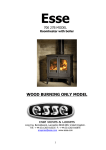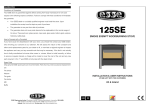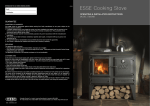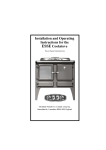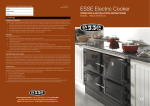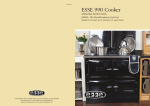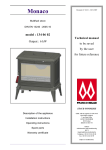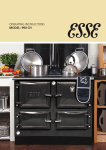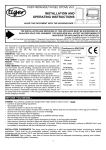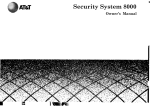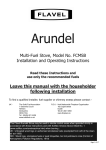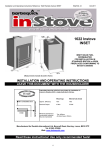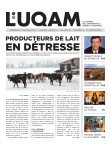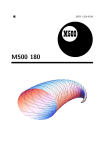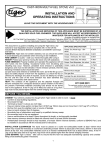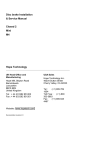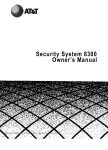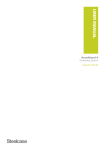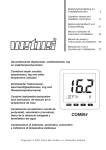Download INSTALLATION AND OPERATING INSTRUCTIONS
Transcript
BIOMASS / MINERAL FUEL
FIREPLACE INSET ROOMHEATER
WITH THERMOSTATIC BOILER
INSTALLATION AND OPERATING INSTRUCTIONS
LEAVE THIS DOCUMENT WITH THE HOUSEHOLDER!
For use only with open-vented, indirect, water systems. Maximum pressure 2 bar. Can be
inter-connected with combi boilers & other heat systems using Esse Centraliser Unit.
All-mechanical thermostatic air supply to fire in response to boiler temperature. No electrical
Control System:
connections or parts. Can be controlled by time clocks, room thermostat etc.
For installation in masonry fireplace with a single dedicated chimney.
Fireplace & Chimney:
Minimum flue draught 14Pa
Clearance:
Physical space: 100mm around in-room parts. From combustibles: 225mm
Extended Burn:
Variable with fuel, heat demand and chimney conditions. Anthracite = c12 hrs
MAXIMUM PERFORMANCE With door closed,
Biomass (Wood Logs)
Mineral Fuel ('Ancit')
burning dry fuel with flue draught of 14Pa
(With type 395 Boiler)
(With type 395 Boiler)
Mean flue temperature: *
395 ºC
364 ºC
Flue gas flow:
8.52 g/sec
13.6 g/sec
Mean CO in flue (as if at 13% O2):
0.4%
0.12%
Efficiency: *
75.7 %
72.7 %
Total output from appliance: *
14.7 kW (50,443 Btu)
14.6 kW (49,802Btu)
Output to room:
3.6 kW (12,437 Btu)
2.8 kW (9,714Btu)
Output to water:
11.1 kW (38,006 Btu)
11.8 kW (40,088Btu)
Fuel per hour at maximum:
3.8 kg
2.4 kg
Maximum achieved at refuelling interval of:
1 hr
2hr
* NOTE: Figures are for heat from the appliance only. There will typically be additional, often substantial, heat gains
from the masonry of the fireplace and chimney, and consequent higher total efficiency. Total performance for a
particular building can be calculated by the method of EN13384
Water
Manufactured by: Esse Engineering Ltd
Long Ing, Barnoldswick, Lancashire BB18 6BN, England
www.esse.com
This document, when completed by the installer, constitutes a 'Hearth Notice' for purposes of the England and Wales
Building Regulations 2000, (App. Doc. J4). It must be left with the householder and placed where it can easily be found.
APPLIANCE SERIAL NUMBER:
INSTALLED AT LOCATION:
Flue Draught
measured on
commissioning:
BY:
Pa
EMERGENCY TELEPHONE:
SIGNED:
DATE:
Who certifies that this installation is safe, has been demonstrated to the householder,
conforms with current building regulations and with these instructions
Fuel used on
commissioning
TO FIND A QUALIFIED INSTALLER, FUEL SUPPLIER or CHIMNEY SWEEP, CONTACT:
UK: The Solid Fuel Association, 7 Swanwick Court, Alfreton, Derbyshire DE55 7AS Tel:0845-601-4406 www.solidfuel.co.uk
RoI: Irish Nationwide Fireplace Organisation, 162 Capel Street, Dublin 1 Tel:01-801-5959 www.fireplace.ie
1
Read these instructions! Use only recommended fuels!
Welcome to more than one-hundred-and-fifty years of Esse. You join the illustrious tribe of Esse fire-keepers, from
Florence Nightingale, Captain Scott, Mrs Beeton, Auguste Escoffier, Queen Victoria and most of the Royal Families of
Europe to Fred Dibnah and Hugh Fearnley-Whittingstall.
An air supply kit is available to bring combustion air directly from
outside the building to the GreenSwitch boiler, greatly reducing the
risk of draughts and significantly improving performance.
THIS APPLIANCE BECOMES EXTREMELY HOT AND
CAN PRODUCE POISONOUS GASES.
A fire-guard should be used if children or the infirm are
present. The installer is required to EXACTLY follow
these instructions and to comply with all local, national
and applicable international standards.
TYPICAL INSTALLATION INTO MASONRY CHIMNEY
This is the traditional method used in Britain and Ireland. Other
methods of installation are possible – ask Esse for a leaflet.
1: Dismantle the boiler. If the unit is supplied assembled, lift off the
top of the front and carefully pull the cylindrical brass thermostat
sensor from its holder. Unfasten the 4 bolts shown, lift the front unit
up slightly and carefully part the two units. Take very great care not
to damage the soft seal.
LOCATION: This appliance is
heavy, a load distribution plate
may be needed on weaker floors.
The appliance must be located on
a flat hearth extending at least
225mm in front of the fire, and of
suitable material to protect the
building from fire. Combustible
materials, including fuels, must be
at least 225mm away from the
room parts of the appliance. This
stove can fit into fireplace
openings of 400 to 460mm wide and 550 to 590mm high. If the
Outside air kit is used, fireplaces must be prepared with an extra
opening to the lower right of the face, as shown.
YOUR CHIMNEY makes your fire work. It stores surplus heat from
the fire, which makes the gas inside its hollow flue lighter, so that it
rises, pulling fresh air through the fuel and making it burn. The
Greenswitch is for connection to a single flue which must be:
● Able to operate safely at temperatures of up to 500°C
● Free from even the slightest leak, and absolutely incapable of
spilling fumes into the dwelling
● Smooth internally, unobstructed and able to be swept along its
entire length.
● Generate a continuous up-draught in use of at least 14Pa
(0.06insWG)
These ends will often be achieved by the chimney being constructed
entirely of masonry or insulated metal components, having an
internal size of more than 150mm but less than 300mm, being
substantially vertical with no severe bends or horizontal portions,
being at least 5m high and terminating at least 1m above any roof.
2: Prepare the setting, fit and test the boiler. Place the boiler/rear
unit on a hearth which will extending at least 250mm in front of the
assembled fire, noting that the final surface of the fireplace will be
just behind the two flanges arrowed. In this example the air supply kit
has been fixed to the side of the boiler with adhesive tape, prior to
being cemented-in. Complete the piping circuit, fill and inspect for
leaks as you won't be able to repair leaks later.
AIR SUPPLY. All fuels need a continuous supply of fresh air from to
burn. There must be an air supply into the room from outside the
building, incapable of being closed off and equal to a total of least
55cm² (=c7.5cm square). Leakage around doors and windows is not
always sufficient, while an extractor fan or another fuel-using
appliance, even in a different room, can remove this air and cause
dangerous fume emission.
2
3: Brick up and form the flueway. Build-up a masonry wall around
the boiler, forming a smooth connection to the flue with no ledges
where debris could collect. Fill any space with mortar-and-rubble. ●
(Shown part-completed)
●
dissipate heat in the event of boiler overheating, irrespective of
how other controls are set.
Means to completely drain water from the system.
A means of dissipating surplus heat, such a permanently
connected radiator or hot-water system.
● Means to allow steam to be released in case of complete
thermostat and electrical failure.
In addition, we recommend:
● Radiators fitted with thermostatic valves.
● An 'anti gravity' valve preventing circulation to upper radiators
when the pump is not running.
● A room-temperature thermostat and single-circuit time-clock
controlling the running of the circulating pump.
The diagram shown one possible arrangement.
MULTI-BOILER SYSTEMS with simultaneous automatic control of
the GreenSwitch and gas, oil, cooker-boilers, heat stores, combi4: Fit fireplace surround. Slot a ready-made fireplace surround in boiler etc. can be achieved using an Esse Centraliser unit. Details
place, or build one up using brick, stone or other masonry or metal are available separately.
materials. Extra fixing, if needed, is through the screw holes shown.
COMMISSIONING The installer must complete the notice at the
beginning of this document, demonstrate the method of lighting,
control and cleaning, and point out the safety requirements to the
householder.
GETTING THE BEST FROM YOUR
Every fuel, chimney and condition of use is different. Only experience
will show which is the best for you. We suggest trying several
different fuels, or mixtures, and different settings of the controls.
GREENSWITCH GETS VERY HOT- Use a glove or the tool supplied
to manipulate hot parts and controls.
5: Refit front and check thermostat: Bolt the door/front unit back in
place, taking great care that the parts seal. Reassemble the interior
fittings and check that the door closes and seals properly. Push the
thermostat sensor fully into its pocket, securing it with a dab of fire
cement. The thermostat is a delicate instrument and, although it is
tested and set at the factory, it may need re-adjusting.
LIGHTING After a period of non-use, do
check the chimney for blockages first!
Empty the ashes. Place two or three
firelighters close together, or screwed-up
paper covered with dry sticks, at the
back of the grate and light them. When
they are burning well gently fill the fire
with dry fuel to the level shown. Don't
over-fill or allow fuel to touch the throat
plate.
EMPTYING ASHES Use the tool to pull
the de-ashing mechanism on the right-hand side of the fire back-and
forth. If it jams, don't force it but wait a few minutes for any
obstructing fuel lump to burn away. Open the door and lift out the
6: Adjusting the thermostat: With the fire cold, the thermostat
ashpan. Let ash cool before disposing in plastic bins. There is no
sensor vial in place and the thermostat control turned to '1' the air
need to empty every speck, but make sure that ash from mineral
closure 'damper' plate should be approximately 7 mm open.
fuels never builds up so that it touches the underside of the grate, or
the grate will melt.
HEATING CIRCUIT
EXTENDED BURNING Allow the fire to burn down to a low, hot fire
bed. Empty the ash and well fill with smaller pieces of hard fuel such
as anthracite.
CLEANING Wipe the body when cool. Soot will condense on the
window if the fuel is damp or if the fire operates at low outputs for
long periods. Deposits will normally burn-off when the next fastburning cycle comes round, but persistent stains can be removed
with a household bleach spray cleaner when the fire is cold.
DOOR Your GreenSwitch is designed to be operated only with the
door closed. Open the door slowly to minimise fumes emission.
AUTOMATIC CONTROL. Your GreenSwitch has three controls.
The GreenSwitch is for connection to open-vented, indirect, water
systems only, with a maximum working pressure of 2 bar. Every
installation must include:
● A pipe thermostat to prevent the pump running if boiler flow
temperature drops below c50°C. This prevents heat from stored
hot water being dumped if the fire dies down and guards against
condensation inside the boiler.
● A pipe thermostat set at about 90°C to run the pump and
3
1)
2)
3)
Boiler thermostat. This senses the temperature of water in the
boiler and automatically allows air in to make the fire burn more
or less fiercely, so that water always leaves the boiler at about
50ºC on setting '1' to about 90ºC at '10'.
GreenSwitch control. Simply pull out for wood, push in for
mineral fuels like anthracite.
Door air control, a slide or spinwheel fitted on some models for
compatibility with non-boiler versions. Keep it closed at all times.
night. Are the door seals sound? Is the flue free from cracks? For
longest burn use hard fuels like anthracite.
SMOKE COMING INTO ROOM Occasional fumes while loading or
de-ashing may occur, but persistent emission to the room must not
be tolerated. First and always, measure the chimney draught, it must
be at least 14Pa in use. Causes of poor draught include:
LEAKS: Even the tiniest crack in the flue can spoil the draught.
BLOCKED FLUE: Pull out the throat plate to inspect. In any case of
doubt have the chimney professionally swept.
COLD FLUE: Smoke only rises if kept hot. Is chimney fully insulated?
LACK OF FRESH AIR: Make sure there is an unobstructed fresh air
supply to the fire.
DOWNDRAUGHT: Wind can blow down the flue if there is something
higher near the chimney such as a tree, hill or high building. Fit an
anti-downdraught cowl to the chimney top.
CHIMNEY FIRE: In the rare event of deposits inside the chimney
igniting (roaring sound + dense smoke and sparks from the chimney)
immediately close the door, shut all air controls and call the fire
brigade. Prevent fires by using very dry fuel and having your
chimney swept regularly.
DIRTY WINDOW. Is fuel absolutely dry? The window will become
dirty when the fire operates at low levels for a long time, but will
usually self-clean at higher burn rates.
FUEL must be dry, with no dust or pieces smaller than about 40mm.
WOOD is a renewable fuel, and, because a burning log can't give out
any more carbon than the tree itself absorbed while living, it is
considered to be greenhouse gas 'neutral'. Fresh wood may seem
dry, but its cells are full of water. Burning such 'green' wood wastes
heat in making steam and produces tarry condensation which will
damage your appliance and chimney. Logs should be split and dried
in a well-ventilated place for one to three years. Only ever use
thoroughly dried-out wood. The white residue from burned wood is
not ash, but cell walls which can burn if kept hot enough, so, with
wood alone, don't de-ash the fire until absolutely necessary.
JOINERY WASTE can be a useful fuel if completely dry, but don't
use timber with preservatives as it can emit very poisonous fumes.
PEAT The nearly black moorland or bog peat should be dried and
treated as for wood.
LIGNITE is a mineral between peat and coal. It lights easily and
burns well, though may produce excessive ash and smoke.
ANTHRACITE is a natural hard, shiny, smokeless, form of coal. It
burns with great heat and lasts a long time.
BRIQUETTES are compressed blocks of fuel, generally able to burn
for long periods and remarkable for their consistency.
NOT RECOMMENDED: PETROLEUM COKE is very high in acid
and will damage your appliance. BITUMINOUS HOUSECOAL is
cheap, but rarely value for money, burns with violent flame and tarry
smoke. It will stain the window, is difficult to control and can explode.
HOUSEHOLD WASTE: Plastics create toxic fumes. Batteries &
aerosols explode! Never use liquid fuels.
MAINTENANCE
EVERY MONTH When the fire is cold, use the operating tool to pull
forward and clean the throat plate. Check that the door seals are
sound.
SMOKE Compliance with smoke regulations is the responsibility of
the user. To ensure low smoke emissions on wood:
1) Make sure the fuel is absolutely dry (less than 15% water)
2) Split logs into pieces no more than about 100mm diameter.
3) Refill 'little and often'
4) Try to load logs 'criss-cross' so that plenty of air can circulate
ANNUALLY, or more often if smoky fuels are used. sweep the entire
around them.
length of the flue from firebox to chimney outlet.
It is often beneficial to burn a little clean mineral fuel, such as
anthracite, along with the wood.
REPLACEABLE PARTS Internal parts will last far longer if special
care is taken to empty ash from mineral fuels regularly, to clean the
SUMMER SHUT DOWN: Before a long period of non-use leave all
throat plate and to use completely dry fuel. The GreenSwitch has
the air controls open to allow ventilation to reduce condensation.
been extensively tested for safety - please don't try to modify it and
always make sure to get genuine spare parts.
PROBLEMS?
NOT ENOUGH HEAT Is fuel really dry? Is chimney draught correct?
Are the room and fire controls set correctly? The GreenSwitch is
designed to provide heat into water, when installed in a large room a
radiator will be needed too.
LACK OF CONTROL Are the door seals sound? Some types of
wood, lignite and coal are difficult to control.
CONDENSATION happens when water vapour touches a cool
surface inside the fire, mixing with combustion products to make
sticky tar. Water comes from the fuel. Even 'dry' wood may hold a
150mm cupful in every 1kg log. Prevent condensation by using only
absolutely dry fuel and fit the correct thermostat to prevent cold
water from circulating through the boiler.
DIFFICULTY BURNING FOR EXTENDED PERIODS The
GreenSwitch is thermostatic, it will keep on making the fuel burn
vigorously for as long as there is a demand for heat, so, if water still
circulates through radiators eg. at night, the fire will continue to burn
– consider adding an 'anti-gravity' valve to stop unwanted circulation
when the pump is off, or simply turn the boiler thermostat down at
Your GreenSwitch is guaranteed (excluding wearable parts) for one
year from the date of purchase, in addition to your statutory rights.
The Esse 300 and 350, Greenswitch Boiler, the 'Furnesse' 'Chroma' and 'Virtine' door designs are registered at the UK Patent Office and protected by Copyright © and UK
Design Right, Glyn Hughes and the Ouzledale Foundry/Esse Engineering 1994-2009. The Esse 350 'Greenswitch' central heating boiler is UK Patent Applied For. Esse
appliances are forever being developed and improved – your appliance you may differ from the one in this booklet. This document Issued 28/10/2008
4




